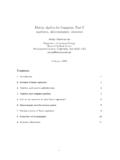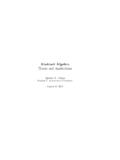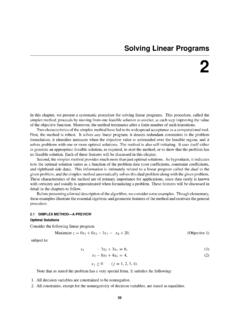Transcription of 1 The Pareto Distribution - University of Montana
1 Estimating the Parameters of a Pareto DistributionIntroducing a Quantile Regression broad approach to using correlation coefficients for pa-rameter estimation and not merely as descriptive statistics has been devel-oped. [1,2,3,4] It was a goal of this project to extend these ideas specificallyto estimating the parameters of the Pareto Distribution . In this paper wewill recall the definition of the Pareto Distribution , some basic properties,and some previously developed methods of estimating the parameters of thePareto Distribution from which a random sample comes. We will introducea new parameter estimation scheme based on correlation coefficients.
2 Fi-nally, we will study and compare the performance of each of the parameterestimation The Pareto DistributionThe Pareto Distribution was first proposed as a model for the distributionof incomes. It is also used as a model for the Distribution of city populationswithin a given area. The Pareto Distribution is defined by the followingfunctions:CDF:F(x| , k) = 1 (kx)a;k x < ; , k >0 PDF:f(x| , k) = k x +1;k x < ; , k >0 The first parameter marks a lower bound on the possible values that a Paretodistributed random variable can take on. To illustrate we can see in figure 1a plot of the density of a Pareto (1, 1) random few well known properties follow:E(X) = k/( 1), >1V ar(X) = k2/[( 1)2( 2)], >212 Parameter EstimationWe are interested in estimating the parameters of the Pareto distributionfrom which a random sample comes.
3 We will outline a few parameter esti-mation Method of MomentsWe actually modify the usual method of moments scheme according to amethod laid out in Johnson and Kotz[5]. If we set the sample mean equalto the Distribution s theoretical expected value mentioned above and if weset the sample minimum,x1, equal to the theoretical expected value of theminimum of a sizensample of Pareto (k, ) random variables, we obtain twoequations and two unknowns: x= k( 1)x1=n kn 1 Solving these equations yields the following estimators: =n x x1n( x x1) k=(n 1)x1n Median EstimatorAs far as the author knows, this is a new estimator.
4 The idea is that inmethod of moments we set the sample mean equal to the theoretical mean,so here we will set the sample median equal to the theoretical median. Manyof the estimation schemes discussed in this paper were first studied in the2case wherekwas known to be equal to one, so that it was only that neededto be estimated. In this case we can see from the CDF above that ifx=ms,the median of the sample, we can estimate as follows:1 m s= =ln2ln msIt is likely though that we will be interested in many cases in whichkis notequal to one, so if we already have an estimate fork, call itkest, we will makethe following adjustment to this estimate for : =ln2ln(mskest)For the purposes of analyzing the performance of this estimator, we will usethe minimum sample value as the estimate Maximum LikelihoodThe likelihood function,L, for the Pareto Distribution has the following form:L(k, |x) =n i=1 k x +1i.
5 0< k min{xi}, >0 Recall that the likelihood function tells as a function of the distributionparameters how likely it is to have observed the data that we did in factobserve. The maximum likelihood estimates forkand are the values ofkand that makeLas large as possible given the data we have. The mostfamiliar method of maximizing functions involves calculus. However, we needno calculus to see thatLgets large beyond bound for increases ink. It iskey then to recall thatkcan be no larger than the smallest value ofxin ourdata, so the best we can do in maximizingLby adjustingkis as follows: k=min{xi}In order to find the maximum likelihood estimate for , calculus is appropri-ate.
6 SinceLis nonnegative, we can take its logarithm. We do this because3it is easier to differentiatelog LthanLitself. Logarithms are bijective func-tions, so the value of that maximizesLalso maximizeslog L. The processin brief looks like this:log L(k, |x) =n i=1log( k x +1i)=n log( ) + nlog(k) ( + 1)n i=1log(xi)= dd =n/ +n log(k) n i=1log(xi)Setting the derivative equal to zero, a little algebra and an omitted secondderivative check to confirm we are maximizingLrather than minimizingLyields: =n/n i=1log(xi k) Correlation CoefficientsGideon[4] has shown using a correlation based interpretation of linear re-gression that the mean and standard deviation for a normally distributeddata set of sizencan be estimated by regression of the sorted data on the1st throughnth (n+ 1)-tiles of the standard normal.
7 In such a regression,the intercept of the fitted linear model serves as an unbiased estimate of themean of the Distribution from which the data came, and the slope of the fittedlinear model serves as an unbiased estimate of the standard deviation. Thisquantile regression estimation scheme not only is appropriate for normallydistributed data though, but rather it works for distributions from any scaleregular connection between regression and correlation is laid out explicitlyin Gideon[4]. We will describe the connection here in brief. The value ofs1A scale regular family is a family of distributions such that for any member in thefamily there is a scalar that can multiply the member to yield another member in the samefamily with unit variance.
8 A common example of the use of the scale regular property ofa scale regular family is standardizing a Normally distributed random satisfies the following equation (See Gideon[1,2,3,4]) estimates standarddeviation:r(q, uo sq) = 0whereqis a vector of the 1st throughnth (n+ 1)-tiles of the standarddistribution,nis the sample size of the data,uois a vector of the ordereddata, andris any correlation coefficient. Whenris Pearson s correlation, thesolution is exactly the least squares estimate of the slope of a linear for an estimate of the model intercept, ifris Pearson s, the estimate is u0 s q. Ifris Kendall sror the Greatest Deviation Correlation Coefficient(See Gideon[2]), the estimate of intercept is median(u0) smedian(q).
9 Againif r is Pearson s correlation coefficient, the solution is exactly the least squaresline. However, it is important to note that r need not be Pearson s r, butrather other correlation statistics will yield estimates, with perhaps moredesirable properties, of the slope and intercept of the will now describe how these ideas can be applied to the Pareto distri-bution. LetXbe a Pareto ( ,k) distributed random variable. ThenU=ln Xis a two-parameter Exponentially distributed random variable with parame-ters and . That isUhas probability density functionf(u) =(1 )e (u )/ ,where = 1/ and =lnk. Its expected value is + or in terms of the orig-inal Pareto random variable, 1/ +ln k, and its variance is 2or 1/ 2.
10 (Thismeans the standard deviation is 1/ .) It should be noted now that the Ex-ponential distributions are a scale regular family. Now the random variableZ= Uwill be rather a standard Exponential with probability densityfunctionf(z) =e (z )and so cumulative density functionF(z) = 1 e (z ).These facts suggest that if we log transform data which we hypothesizeto be Pareto distributed, we can solver(q, u0 sq) = 0,qbeing the quantilesof the standard Exponential, to get an estimate of the scale parameter forthe Exponential Distribution to which the log transformed Pareto data cor-responds, and the appropriate center measure,i, of the uncentered residualswill give an estimate of the location parameter of the Exponential distribu-tion to which the log transformed Pareto data corresponds.









